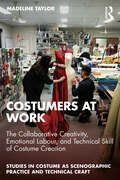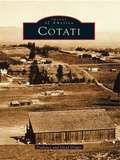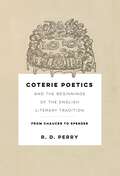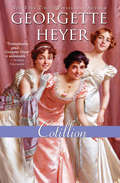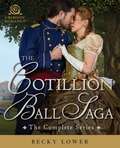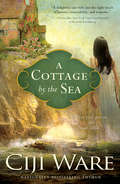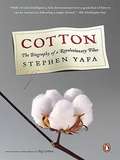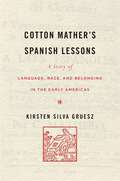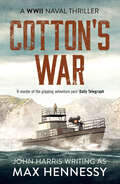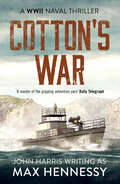- Table View
- List View
Costume, Makeup, and Hair
by Robin Blaetz Tamar Jeffers Mcdonald Prudence Black Adrienne L. Mclean Drake Stutesman James Castonguay Karen De Perthuis Mary DesjardinsMovie buffs and film scholars alike often overlook the importance of makeup artists, hair stylists, and costumers. With precious few but notable exceptions, creative workers in these fields have received little public recognition, even when their artistry goes on to inspire worldwide fashion trends. From the acclaimed Behind the Silver Screen series, Costume, Makeup, and Hair charts the development of these three crafts in the American film industry from the 1890s to the present. Each chapter examines a different era in film history, revealing how the arts of cinematic costume, makeup, and hair, have continually adapted to new conditions, making the transitions from stage to screen, from monochrome to color, and from analog to digital. Together, the book's contributors give us a remarkable glimpse into how these crafts foster creative collaboration and improvisation, often fashioning striking looks and ingenious effects out of limited materials. Costume, Makeup, and Hair not only considers these crafts in relation to a wide range of film genres, from sci-fi spectacles to period dramas, but also examines the role they have played in the larger marketplace for fashion and beauty products. Drawing on rare archival materials and lavish color illustrations, this volume provides readers with both a groundbreaking history of film industry labor and an appreciation of cinematic costume, makeup, and hairstyling as distinct art forms.
Costumers at Work: The Collaborative Creativity, Emotional Labour, and Technical Skill of Costume Creation (Studies in Costume as Scenographic Practice and Technical Craft)
by Madeline TaylorCostumers at Work: The Collaborative Creativity, Emotional Labour, and Technical Skill of Costume Creation explores the various forms of work carried out in the costume workshop by the myriads of skilled professionals who transform ideas and sketches into the wearable costumes seen on stage.Costume work, as collective, collaborative, and material labour produced by a predominantly female workforce, has been long overlooked by the performance industry and those who study it. This book exposes the inherent tensions between theatre’s strict hierarchies and collaborative ideology and how these inform the structures negotiated day to day by costumers as they carry out their work. Through close attention to their work, the book establishes costumers’ work as collaborative and complex, a creative and emotional labour that contributes to enhanced storytelling, actor performance, and audience experience. Using extensive ethnographic observation conducted over 14 months at three professional theatre costume workshops around Australia, combined with extant interviews and research from across the globe, Costumers at Work provides explicit theories and guidance about the behaviours, skills, and communication modes that make costume collaboration more effective and enjoyable.This book is written for costume researchers, practitioners, and students of theatrical costume design and construction, along with theatre scholars broadly.
Costuming the Shakespearean Stage: Visual Codes of Representation in Early Modern Theatre and Culture (Studies In Performance And Early Modern Drama Ser.)
by Robert I. LublinAlthough scholars have long considered the material conditions surrounding the production of early modern drama, until now, no book-length examination has sought to explain what was worn on the period's stages and, more importantly, how articles of apparel were understood when seen by contemporary audiences. Robert Lublin's new study considers royal proclamations, religious writings, paintings, woodcuts, plays, historical accounts, sermons, and legal documents to investigate what Shakespearean actors actually wore in production and what cultural information those costumes conveyed. Four of the chapters of Costuming the Shakespearean Stage address 'categories of seeing': visually based semiotic systems according to which costumes constructed and conveyed information on the early modern stage. The four categories include gender, social station, nationality, and religion. The fifth chapter examines one play, Thomas Middleton's A Game at Chess, to show how costumes signified across the categories of seeing to establish a play's distinctive semiotics and visual aesthetic.
Cotati (Images of America)
by Lloyd Draper Prudence DraperThe town of Cotati, once the Coast Miwok village of Kot'ati, was by 1850 a 17,000-acre diamond-shaped ranch set in the center of Sonoma County's golden fields. Dr. Thomas Stokes Page and his heirs ran that ranch until the 1890s, when they laid out a town and a distinctive hexagonal plaza with streets named after Dr. Page's sons. That wheel-like plaza earned centrally located Cotati the title, "Hub of Sonoma County." For many years Cotati was the gathering place for hundreds of hardworking chicken ranchers, who bought up small farms in the surrounding countryside, but it was transformed in the 1970s into a hippie haven fed by nearby Sonoma State University. Old chicken houses then became student housing and the Plaza hub that was the setting for traditional community festivals became a vibrating stage for dancing and demonstrations. Cotati's famous downtown nightclub, the Inn of the Beginning, was the proving ground for many now-famous musicians, including John Lee Hooker, Huey Lewis, Vince Guaraldi, Roseanne Cash, and Kate Wolf.
Coterie Poetics and the Beginnings of the English Literary Tradition: From Chaucer to Spenser (The Middle Ages Series)
by R. D. PerryIn Coterie Poetics and the Beginnings of the English Literary Tradition, R. D. Perry reveals how poetic coteries formed and maintained the English literary tradition. Perry shows that, from Geoffrey Chaucer to Edmund Spenser, the poets who bridged the medieval and early modern periods created a profusion of coterie forms as they sought to navigate their relationships with their contemporaries and to the vernacular literary traditions that preceded them. Rather than defining coteries solely as historical communities of individuals sharing work, Perry reframes them as products of authors signaling associations with one another across time and space, in life and on the page. From Geoffrey Chaucer’s associations with both his fellow writers in London and with his geographically distant French contemporaries, to Thomas Hoccleve’s emphatic insistence that he was “aqweyntid” with Chaucer even after Chaucer’s death, to John Lydgate’s formations of “virtual coteries” of a wide range of individuals alive and dead who can only truly come together on the page, the book traces how writers formed the English literary tradition by signaling social connections.By forming coteries, both real and virtual, based on shared appreciation of a literary tradition, these authors redefine what should be valued in that tradition, shaping and reshaping it accordingly. Perry shows how our notion of the English literary tradition came to be and how it could be imagined otherwise.
Cotillion
by Georgette Heyer"My favourite historical novelist. "-Margaret Drabble"Sparkling. "-Independent on SundayA sham betrothal isn't the only thing that gets Kitty and Freddy into trouble, but it's definitely the beginning . . A most unusual heroFreddy is immensely rich, of course, and not bad-looking, but he's mild-mannered, a bit hapless-not anything like his virile, handsome, rakish cousin Jack . . . A heroine in a difficult situationYoung Kitty Charing stands to inherit a vast fortune from her irascible and eccentric guardian-provided she marries one of his great-nephews . . . A sham betrothal No sooner does Kitty arrive in London then the race for her hand begins, but between confirmed rakes and bumbling affections, Kitty needs a daring scheme . . . "Thus begins Cotillion, arguably the funniest, most charming of Georgette Heyer's many delightful Regency romances. "-Amazon. co. uk"Triumphantly good . . . Georgette Heyer is unbeatable. " -Sunday Telegraph
Cotillion Ball Saga: The Complete Series
by Becky LowerYou'll fall in love with the spirited Fitzgerald family as they find romance in turbulent Civil War-era America. Raised to defy societal convention and follow their passions, these siblings' rebellious hearts meet their matches. Settle in to enjoy these 10 tales of independent, passionate, and strong American heroines!The Reluctant Debutante: Ginger Fitzpatrick would rather be rallying for women's rights than attending the Cotillion Ball—until she sets her eye on Joseph Lafontaine, a half Ojibwa Indian, whom New York society deems totally unsuitable for marriage to a fine, cultured young lady. But love knows no such boundaries...The Abolitionist's Secret: Heather Fitzpatrick falls for young army lieutenant David Whitman, who is tracking the runaway slave she rescued a few nights earlier. Can their attraction survive the coming divide between North and South?Banking on Temperance: At age 23, Basil Fitzpatrick is the owner of the St. Louis branch of the family banking business and has his pick of the ladies--but it's impoverished spitfire Temperance Jones, daughter of a circuit-riding preacher, who catches his eye. She's determined to get to Oregon--does he have the courage to follow?The Tempestuous Debutante: The smart choice says Jasmine Fitzpatrick should choose to charm the Viscount of Foxborough at this season's Cotillion, but the noble's stable boy, Parr O'Shaughnessy, may hold the key to her heart.Blinded by Grace: Grace Wagner has been in love with Halwyn Fitzpatrick since they were teens, but now she needs a husband in order to inherit the trust her father has left for her. Will Halwyn's new glasses help him see her in a new light, or will she take control and propose to him herself?The Duplicitous Debutante: Writing the popular Harry Hawk dime novels as F.P. Elliott, Rosemary Fitzpatrick is busy hiding her female identity from her new publisher, Henry Cooper. But Henry is not the typical Boston Brahmin nor the typical publisher. When her deception begins to unravel at the Cotillion Ball, will Henry be able to forgive her, or has deceit cost her the man she loves?Expressly Yours, Samantha: To escape her wicked uncle, Samantha Hughes cuts her hair to pose as a man and become Sam Hughes, a Pony Express rider. Valerian Fitzpatrick joins the hard-riding circuit in an attempt to escape life in the family business. As he and Sam grow close, Valerian's more than willing to protect her secret, but when Sam's forced to run yet again, does a future with her mean giving up the freedom he's always craved?A Widow's Salvation: Volunteering at the army hospital, widow Pepper Fitzpatrick Brown meets Colonel Elijah Williams, the head surgeon who can't shake his experiences in the bloody war. It's hard to find happiness in a war-torn United States, but these two wounded souls stand a fighting chance--if they can save what's left of their hearts.The Forgotten Debutante: Saffron Fitzpatrick spent her teenage years mourning the dead rather than dancing at her debutante ball, with the exception of one forbidden kiss with solider Ezekiel Boone. Fate reunites the couple three years later, and they discover unexpected common ground and begin to build a relationship. But though the war is over, a future together may still elude them...especially if Saffron's brother and the U.S. Army have anything to say about it.An Unconventional Courtship: Discover where it all began with this bonus novella featuring the Fitzpatrick parents! Charlotte Ashcroft knows her family would never approve of her attending a women's rights speech in New York City alone. So when a busybody from back home confronts Charlotte, she grabs the man in a jaunty blue hat nearby and introduces him as her escort. What's an up-and-coming young banker like George Fitzpatrick to do but help a lady out?Sensuality Level: Sensual
Cotillion Ball Saga: The Complete Series
by Becky LowerFall in love with the spirited Fitzgerald family as they find romance in turbulent Civil War-era America. Settle in to enjoy these ten tales of independent American heroines who meet their rebellious matches!The Reluctant Debutante: Ginger Fitzpatrick would rather be rallying for women’s rights than attending the Cotillion Ball—until she sets her eye on Joseph Lafontaine, a half Ojibwa Indian, whom New York society deems her unsuitable to marry. But love knows no such boundaries… The Abolitionist’s Secret: Heather Fitzpatrick falls for young army lieutenant David Whitman, who is tracking the runaway slave she rescued a few nights earlier. Can their attraction survive the coming divide between North and South? Banking on Temperance: Banking heir Basil Fitzpatrick has his pick of the ladies—but it’s impoverished spitfire Temperance Jones, daughter of a circuit-riding preacher, who catches his eye. She’s determined to get to Oregon—does he have the courage to follow? The Tempestuous Debutante: The smart choice says Jasmine Fitzpatrick should choose to charm the Viscount of Foxborough at this season’s Cotillion, but the noble’s stable boy, Parr O’Shaughnessy, may hold the key to her heart. Blinded by Grace: Grace Wagner has loved Halwyn Fitzpatrick since they were teens. When she needs a husband to inherit a trust, will Halwyn’s new glasses help him see her in a new light, or will she take control and propose? The Duplicitous Debutante: Rosemary Fitzpatrick hides her female identity as dime novelist F.P. Elliott, from new publisher Henry Cooper. When her deception begins to unravel at the Cotillion Ball, will deceit cost her the man she’s come to love? Expressly Yours, Samantha: To escape her wicked uncle, Samantha Hughes cuts her hair and joins the Pony Express as a man. Valerian Fitzpatrick’s fleeing life in the family business, but he and Sam fall in love once her secret’s uncovered. But does a future with her mean giving up the freedom he’s always craved? A Widow’s Salvation: Volunteering at the army hospital, widow Pepper Fitzpatrick Brown meets head surgeon Colonel Elijah Williams. It’s hard to find happiness in a war-torn United States, but these two wounded souls stand a fighting chance—if they can save what’s left of their hearts. The Forgotten Debutante: Saffron Fitzpatrick spent her teenage years mourning the dead rather than dancing at her debutante ball, with the exception of one forbidden kiss with soldier Ezekiel Boone. Fate reunites the couple three years later, and they discover unexpected common ground. An Unconventional Courtship: Discover where it all began with this bonus novella featuring the Fitzpatrick parents! When a busybody from back home confronts Charlotte Ashcroft, who’s attending a women’s rights speech in New York City alone, she grabs the man in a jaunty blue hat nearby and introduces him as her escort. What’s an up-and-coming young banker like George Fitzpatrick to do but help a lady out?
Cottage Economy
by William CobbettThe American publication of Cottage Economy by Stephen Gould and Sons was basically a compilation of a series of pamphlets published by Cobbett in 1821 in England. Cobbett was an English political activist at a time when the industrial revolution was changing the face of rural Britain, and he was constantly concerned with improving the living conditions of the working classes. The book presents his philosophy that a laborer should be taught industry, sobriety, frugality, and &“the duty of using his best exertions for the rearing of his family.&”With practical instructions still relevant for those seeking self-reliance, Cobbett teaches the working classes of the 19th century the arts of brewing beer, keeping livestock, making bread, and &“other matters deemed useful in conducting affairs of a labourer&’s family.&” Contents include &“information relative to the brewing of beer, the making of bread, keeping of cows, pigs, bees, ewes, goats, poultry, and rabbits . . . to which are added instructions relative to the selecting, the cutting, and the bleaching of the plants of English grass and grain, for the purpose of making hats and bonnets. This edition of Cottage Economy was reproduced by permission from the volume in the collection of the American Antiquarian Society, Worcester, Massachusetts. Founded in 1812 by Isaiah Thomas, a Revolutionary War patriot and successful printer and publisher, the Society is a research library documenting the life of Americans from the colonial era through 1876. The Society collects, preserves, and makes available as complete a record as possible of the printed materials from the early American experience. The cookbook collection includes approximately 1,100 volumes.
Cottage Grove
by Angela Garvin Caleb GarvinCottage Grove is a picturesque little hometown nestled in the Willamette Valley. Pioneers following the Oregon Trail west settled in the area in the early 1800s. The Bohemia Mountains were the first major draw to the area after James "Bohemia" Johnson discovered gold in 1863. A gold rush ensued and caused several boom towns to spring up on the route to the mines. After several years, many millions in gold were blasted from the mountains. There is an estimated $14 million in gold remaining in the mountain to this day. With new settlers came the first post offices and schools. When the mining started to slow down, the lumber industry was on the upswing. With easy access to the short line and virgin timber on every hill in the valley, timber became the new boom. Mills sprung up almost overnight, and in some cases burned in a single night. At one time, there were 23 mills on Row River alone.
Cottage by the Sea
by Ciji WareA remote cottage on the wild coast of Cornwall sounded to Blythe Barton Stowe like the perfect escape from the pain and humiliation of recent events in her Hollywood life. But soon she seems to be reliving a centuries-old tragedy, and the handsome owner of the shabby manor house on the hill appears vitally entwined in her destiny. As they unearth one shocking family secret after another, Blythe is forced to conclude that her intriguing neighbor is more than just an impecunious British gentleman bent on saving his ancestral home. And the impeccably honorable Lucas Teague begins to see Blythe as a lifeline in an otherwise bleak existence. But is the unbridled attraction they're experiencing a dangerous distraction, or could it be strong enough to transcend the insurmountable complexities of time and place...?
Cotting School (Campus History)
by Elizabeth Campbell Peters David ManzoIn 1893, two pioneering orthopedic surgeons, Dr. Augustus Thorndike and Dr. Edward Bradford, saw the need to educate children whose physical challenges prevented them from attending school. As an experiment, they founded the Industrial School for Crippled and Deformed Children in Boston. Modeled after 19th-century European institutions, the school was America's first for children with physical disabilities. Early classes were held in a church basement where Mary Perry volunteered to teach seven students. Tuition, a hot meal, and transportation in a horse-drawn carriage were free. Thanks to the leadership of the two doctors and board chairman Francis Joy Cotting, within 10 years the school was housed in an impressive, debt-free brick building. Renamed the Cotting School, the school is now located in Lexington and serves 130 day students from 74 communities. Staffed with highly skilled special education teachers; nurses; physical, occupational, and communication therapists; and dental and vision specialists, Cotting is a national leader in serving children with a broad spectrum of learning and communication disabilities, physical challenges, and complex medical conditions.
Cotton
by Stephen YafaIn the tradition of Mark Kurlansky's Cod and Salt, this endlessly revealing book reminds us that the fiber we think of as ordinary is the world's most powerful cash crop, and that it has shaped the destiny of nations. Ranging from its domestication 5,500 years ago to its influence in creating Calvin Klein's empire and the Gap, Stephen Yafa's Cotton gives us an intimate look at the plant that fooled Columbus into thinking he'd reached India, that helped start the Industrial Revolution as well as the American Civil War, and that made at least one bug—the boll weevil—world famous. A sweeping chronicle of ingenuity, greed, conflict, and opportunism, Cotton offers "a barrage of fascinating information" (Los Angeles Times). .
Cotton Capitalists: American Jewish Entrepreneurship in the Reconstruction Era (Goldstein-Goren Series in American Jewish History #8)
by Michael R. CohenHonorable Mention, 2019 Saul Viener Book Prize, given by the American Jewish Historical SocietyA vivid history of the American Jewish merchants who concentrated in the nation’s most important economic sector In the nineteenth century, Jewish merchants created a thriving niche economy in the United States’ most important industry—cotton—positioning themselves at the forefront of expansion during the Reconstruction Era. Jewish success in the cotton industry was transformative for both Jewish communities and their development, and for the broader economic restructuring of the South. Cotton Capitalists analyzes this niche economy and reveals its origins. Michael R. Cohen argues that Jewish merchants’ status as a minority fueled their success by fostering ethnic networks of trust. Trust in the nineteenth century was the cornerstone of economic transactions, and this trust was largely fostered by ethnicity. Much as money flowed along ethnic lines between Anglo-American banks, Jewish merchants in the Gulf South used their own ethnic ties with other Jewish-owned firms in New York, as well as Jewish investors across the globe, to capitalize their businesses. They relied on these family connections to direct Northern credit and goods to the war-torn South, avoiding the constraints of the anti-Jewish prejudices which had previously denied them access to credit, allowing them to survive economic downturns. These American Jewish merchants reveal that ethnicity matters in the development of global capitalism. Ethnic minorities are and have frequently been at the forefront of entrepreneurship, finding innovative ways to expand narrow sectors of the economy. While this was certainly the case for Jews, it has also been true for other immigrant groups more broadly. The story of Jews in the American cotton trade is far more than the story of American Jewish success and integration—it is the story of the role of ethnicity in the development of global capitalism.
Cotton Mather, Jonathan Edwards, and the Quest for Evangelical Enlightenment: Scripture and Experimental Religion (Christianities in the Trans-Atlantic World)
by Ryan P. HoseltonThis book explores the early evangelical quest for enlightenment by the Spirit and the Word. While the pursuit originated in the Protestant Reformation, it assumed new forms in the long eighteenth-century context of the early Enlightenment and transatlantic awakened Protestant reform. This work illuminates these transformations by focusing on the dynamic intersection of experimental philosophy and experimental religion in the biblical practices of early America’s most influential Protestant theologians, Cotton Mather (1663-1728) and Jonathan Edwards (1703-1758). As the first book-length project to treat Mather and Edwards together, this study makes an important contribution to the extensive scholarship on these figures, opening new perspectives on the continuities and complexities of colonial New England religion. It also provides new insights and interpretive interventions concerning the history of the Bible, early modern intellectual history, and evangelicalism’s complex relationship to the Enlightenment.
Cotton Mather’s Spanish Lessons: A Story of Language, Race, and Belonging in the Early Americas
by Kirsten Silva GrueszA sweeping history of linguistic and colonial encounter in the early Americas, anchored by the unlikely story of how Boston’s most famous Puritan came to write the first Spanish-language publication in the English New World.The Boston minister Cotton Mather was the first English colonial to refer to himself as an American. He was also the first to author a Spanish-language publication: La Fe del Christiano (The Faith of the Christian), a Protestant tract intended to evangelize readers across the Spanish Americas. Kirsten Silva Gruesz explores the conditions that produced La Fe del Christiano, from the intimate story of the “Spanish Indian” servants in Mather’s household, to the fragile business of printing and bookselling, to the fraught overlaps of race, ethnicity, and language that remain foundational to ideas of Latina/o/x belonging in the United States today.Mather’s Spanish project exemplifies New England’s entanglement within a partially Spanish Catholic, largely Indigenous New World. British Americans viewed Spanish not only as a set of linguistic practices, but also as the hallmark of a rival empire and a nascent racial-ethnic category. Guided by Mather’s tract, Gruesz explores English settlers’ turbulent contacts with the people they called “Spanish Indians,” as well as with Black and local native peoples. Tracing colonial encounters from Boston to Mexico, Florida, and the Caribbean, she argues that language learning was intimately tied with the formation of new peoples. Even as Spanish has become the de facto second language of the United States, the story of La Fe del Christiano remains timely and illuminating, locating the roots of latinidad in the colonial system of the early Americas.Cotton Mather’s Spanish Lessons reinvents our understanding of a key colonial intellectual, revealing notions about language and the construction of race that endure to this day.
Cotton Song
by Tom BaileyIn World War II-era Mississippi, the aftermath of a tragedy takes on all the intensity and heat of the Delta summer when the town of Ruleton copes with violence, racism, and a vengeful spree that threatens the life of a young girl and the soul of the small town. In Hushpuckashaw County in the 1940s, many things are desperately unfair. Letitia Johnson, a young black mother and the nanny for one of the town's most distinguished couples, knows this only too well when the couple's baby is found drowned in its bath. Accused by the grieving family and the enraged townspeople, Letitia quickly sends her twelve-year-old daughter, Sally, out to hide in the brush before she is taken into custody. The angry mob would get revenge when they drag Letitia from her jail cell and hang her that very night. But they wouldn't get Sally. Baby Allen, a courageous social worker, is assigned to Sally's case, and gradually coaxes the young girl out of hiding, wins her trust, and secures her protection. But once Sally is safe, Baby is left with the greater mission of uncovering the truth about who is responsible for the infant's death--a shocking revelation that will change the ways and attitudes of a town that has been long in need of changing. Beautiful and gripping,Cotton Song is the story of a woman's fight to save the child left behind after the horrific lynching that took her mother's life.
Cotton Song
by Tom BaileyIn World War II-era Mississippi, the aftermath of a tragedy takes on all the intensity and heat of the Delta summer when the town of Ruleton copes with violence, racism, and a vengeful spree that threatens the life of a young girl and the soul of the small town.In Hushpuckashaw County in the 1940s, many things are desperately unfair. Letitia Johnson, a young black mother and the nanny for one of the town's most distinguished couples, knows this only too well when the couple's baby is found drowned in its bath. Accused by the grieving family and the enraged townspeople, Letitia quickly sends her twelve-year-old daughter, Sally, out to hide in the brush before she is taken into custody. The angry mob would get revenge when they drag Letitia from her jail cell and hang her that very night. But they wouldn't get Sally.Baby Allen, a courageous social worker, is assigned to Sally's case, and gradually coaxes the young girl out of hiding, wins her trust, and secures her protection. But once Sally is safe, Baby is left with the greater mission of uncovering the truth about who is responsible for the infant's death--a shocking revelation that will change the ways and attitudes of a town that has been long in need of changing. Beautiful and gripping, Cotton Song is the story of a woman's fight to save the child left behind after the horrific lynching that took her mother's life.From the Hardcover edition.
Cotton Tenants
by James Agee Adam Haslett John Summers Walker EvansA re-discovered masterpiece of reporting by a literary icon and a celebrated photographerIn 1941, James Agee and Walker Evans published Let Us Now Praise Famous Men, a 400-page prose symphony about three tenant farming families in Hale County, Alabama, at the height of the Great Depression. The book shattered journalistic and literary conventions. Critic Lionel Trilling called it the "most realistic and most important moral effort of our American generation." The origins of Agee and Evans's famous collaboration date back to an assignment for Fortune magazine, which sent them to Alabama in the summer of 1936 to report a story that was never published. Some have assumed that Fortune's editors shelved the story because of the unconventional style that marked Famous Men, and for years the original report was presumed lost. But fifty years after Agee's death, a trove of his manuscripts turned out to include a typescript labeled "Cotton Tenants." Once examined, the pages made it clear that Agee had in fact written a masterly, 30,000-word report for Fortune. Published here for the first time, and accompanied by thirty of Walker Evans's historic photos, Cotton Tenants is an eloquent report of three families struggling through desperate times. Indeed, Agee's dispatch remains relevant as one of the most honest explorations of poverty in America ever attempted and as a foundational document of long-form reporting. As the novelist Adam Haslett writes in an introduction, it is "a poet's brief for the prosecution of economic and social injustice."
Cotton's War (The WWII Naval Thrillers)
by Max HennessyOne man stands in the way of an army in this relentless wartime thriller from &“a master of the gripping adventure yarn&” (The Daily Telegraph). Storming their way through Europe, the Nazis forces have made their way east to the Mediterranean, and are almost sure to conquer Greece. But they didn&’t bargain on coming up against Michael Anthony Cotton, a heroic marine who smuggles weapons and money to the Greek Resistance. As the conflict reaches a fever pitch, Cotton must venture on one last lethal mission, involving guns and high-speed pursuits, if he is to protect his homeland from the invading force. An unforgettable, action-packed thriller set against the dazzle of the Aegean, perfect for fans of Alexander Fullerton, Alan Evans and Antony Trew.
Cotton's War (WWII Naval Thrillers)
by Max HennessyOne man stands in the way of an army.Storming their way through Europe, the Nazis forces have made their way east to the Mediterranean, and are almost sure to conquer Greece.But they didn’t bargain on coming up against Michael Anthony Cotton, a heroic marine who smuggles weapons and money to the Greek Resistance.As the conflict reaches a fever pitch, Cotton must venture on one last lethal mission, involving guns and high-speed pursuits, if he is to protect his homeland from the invading force.An unforgettable, action-packed thriller set against the dazzle of the Aegean, perfect for fans of Alexander Fullerton, Alan Evans and Antony Trew.
Cotton, Climate, and Camels in Early Islamic Iran: A Moment in World History
by Richard BullietA boom in the production and export of cotton made Iran the richest region of the Islamic caliphate in the ninth and tenth centuries. Yet in the eleventh century, Iran's impressive agricultural economy entered a steep decline, bringing the country's primacy to an end.Richard W. Bulliet advances several provocative theses to explain these hitherto unrecognized historical events. According to Bulliet, the boom in cotton production directly paralleled the spread of Islam, and Iran's agricultural decline stemmed from a significant cooling of the climate that lasted for over a century. The latter phenomenon also prompted Turkish nomadic tribes to enter Iran for the first time, establishing a political dominance that would last for centuries.Substantiating his argument with innovative quantitative research and recent scientific discoveries, Bulliet first establishes the relationship between Iran's cotton industry and Islam and then outlines the evidence for what he terms the "Big Chill." Turning to the story of the Turks, he focuses on the lucrative but temperature-sensitive industry of cross-breeding one-humped and two-humped camels. He concludes that this unusual concatenation of events had a profound and long-lasting impact not just on the history of Iran but on the development of world affairs in general.
Cotton, Climate, and Camels in Early Islamic Iran: A Moment in World History
by Richard W. BullietA boom in the production and export of cotton made Iran the richest region of the Islamic caliphate in the ninth and tenth centuries. Yet in the eleventh century, Iran's impressive agricultural economy entered a steep decline, bringing the country's primacy to an end. Richard W. Bulliet advances several provocative theses to explain these hitherto unrecognized historical events. According to Bulliet, the boom in cotton production directly paralleled the spread of Islam, and Iran's agricultural decline stemmed from a significant cooling of the climate that lasted for over a century. The latter phenomenon also prompted Turkish nomadic tribes to enter Iran for the first time, establishing a political dominance that would last for centuries. Substantiating his argument with innovative quantitative research and recent scientific discoveries, Bulliet first establishes the relationship between Iran's cotton industry and Islam and then outlines the evidence for what he terms the "Big Chill." Turning to the story of the Turks, he focuses on the lucrative but temperature-sensitive industry of cross-breeding one-humped and two-humped camels. He concludes that this unusual concatenation of events had a profound and long-lasting impact not just on the history of Iran but on the development of world affairs in general.
Cotton: From Southern Fields to the Memphis Market
by William BeardenA written and photographic history of cotton’s role in American society, from the author of Memphis Blues.In the barbeque joints and plate lunch cafes off Memphis’s Front Street, one is easily reminded of the days when cotton was king. It was a society of characters and cads; the big time and the small time; the rich and the richer; the hangers-on, anointed, powerful, and busted. Cotton created empires in agriculture, transportation, banking, and warehousing. It also shackled the dreams and lives of those born into slavery and sharecropping. Although many of the day-to-day dealings have moved to manicured office parks and high-rise buildings, cotton’s influence remains at the core of the Southern economy and Southern society. Cotton propelled technological advances that have changed the face and soul of the South. It was the wellspring that gave birth to modern music. Cotton triggered the migrations of millions of blacks and poor whites, shaping the culture of Northern cities. Its allure has called out to writers, artists, and photographers from around the world, attracted by the tragedy, irony, and power of cotton’s story. In this book of vivid images and intriguing text, Memphis historian and author William Bearden presents the captivating history of cotton’s profound influence on American society.
Cotton: The Biography of a Revolutionary Fiber
by Stephen YafaIn the tradition of Mark Kurlansky's Cod and Salt, this endlessly revealing book reminds us that the fiber we think of as ordinary is the world's most powerful cash crop, and that it has shaped the destiny of nations. Ranging from its domestication 5,500 years ago to its influence in creating Calvin Klein's empire and the Gap, Stephen Yafa's Cotton gives us an intimate look at the plant that fooled Columbus into thinking he'd reached India, that helped start the Industrial Revolution as well as the American Civil War, and that made at least one bug--the boll weevil--world famous. A sweeping chronicle of ingenuity, greed, conflict, and opportunism, Cotton offers "a barrage of fascinating information" (Los Angeles Times).

